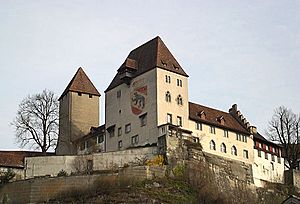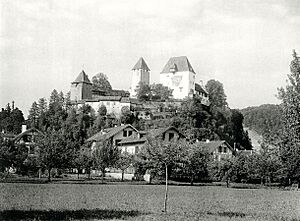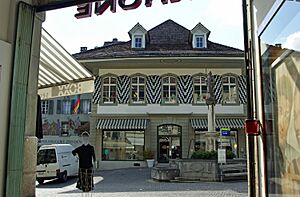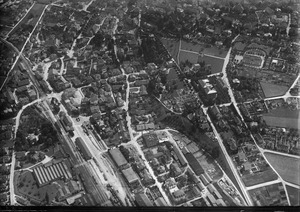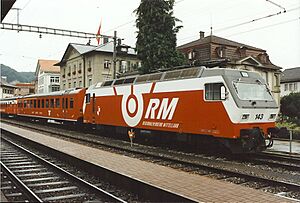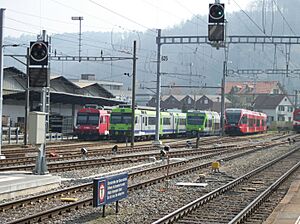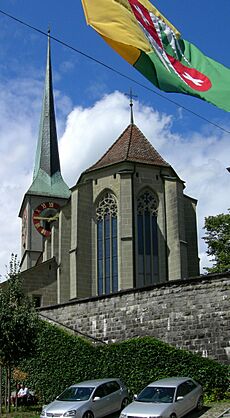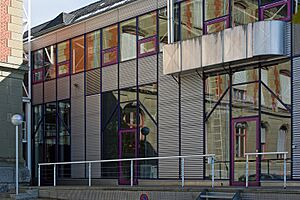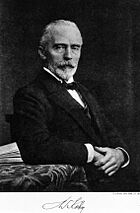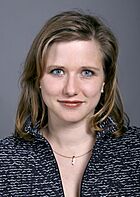Burgdorf, Switzerland facts for kids
Quick facts for kids
Burgdorf
|
||
|---|---|---|
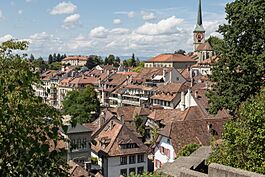
Old city of Burgdorf
|
||
|
||
| Country | Switzerland | |
| Canton | Bern | |
| District | Emmental | |
| Area | ||
| • Total | 15.56 km2 (6.01 sq mi) | |
| Elevation | 533 m (1,749 ft) | |
| Population
(Dec 2020 )
|
||
| • Total | 16,583 | |
| • Density | 1,065.7/km2 (2,760.3/sq mi) | |
| Postal code |
3400
|
|
| Surrounded by | Hasle bei Burgdorf, Heimiswil, Kirchberg, Krauchtal, Lyssach, Mötschwil, Oberburg, Rüti bei Lyssach, Wynigen | |
| Twin towns | Epesses (Switzerland), Burgdorf (Germany), San Pellegrino Terme (Italy) | |
Burgdorf (also called French: Berthoud in French) is the biggest city in the Emmental region of Switzerland. It's located in the canton of Bern. Until 2010, Burgdorf was the capital of its own district. Now, it's part of the larger Emmental district.
Contents
- What's in a Name?
- Burgdorf's Past
- Where is Burgdorf?
- Burgdorf's Symbol
- Who Lives in Burgdorf?
- How Burgdorf's Population Grew
- Important Historic Sites
- Sister Cities
- Burgdorf's Economy
- Religion in Burgdorf
- Weather in Burgdorf
- Learning in Burgdorf
- Getting Around
- Famous People from Burgdorf
- Fun Events in Burgdorf
- See also
What's in a Name?
The city is called Burgdorf in German. In French, it's known as Berthoud. This name is not a direct translation. It honors Berchthold V, Duke of Zähringen. He put up a special plaque at the city's entrance. This plaque celebrated his victory against the people of Burgundy.
Burgdorf's Past
Archaeological finds show that people lived in the Burgdorf area a very long time ago. This includes the Stone Age, Bronze Age, and Hallstatt period.
During the Middle Ages, the land belonged to the Kingdom of Burgundy. After 1080, it was owned by the Dukes of Zähringen. They built a castle on the Emme river. Burgdorf is first mentioned in 1236. The castle itself was mentioned even earlier, in 1080.
The Zähringen dukes built a city around the castle in the late 1100s. After their family line ended, Burgdorf went to the Counts of Kyburg. They made the city bigger in 1278. By 1300, the city had grown to fill its walls. For a long time, no new buildings were allowed inside the city walls.
Under the Kyburg Counts, Burgdorf Castle was the capital of their area. The Counts also acted as mayors of Burgdorf town.
The Siege of Burgdorf
In the 1300s, the Kyburg Counts got into a lot of debt. In 1382, Count Rudolf II of Neu-Kyburg attacked the city of Solothurn. He hoped to make them forgive his debts. This attack gave the city of Bern a reason to break away from the Neu-Kyburgs.
In March 1383, an army from Bern and Solothurn marched on Burgdorf. This army had help from other Swiss regions. They brought powerful weapons like catapults and early guns. Count Rudolf II had died, so his uncle, Berchtold I, defended Burgdorf.
Burgdorf held out for 45 days against the attack. Bern eventually asked for help to end the war. On April 5, 1384, the Neu-Kyburgs agreed to sell Burgdorf and Thun to Bern.
Burgdorf's Special Rights
As part of the peace deal, Bern agreed to respect Burgdorf's rights. Burgdorf had a lot of freedom compared to other cities in Bern's control. The town had its own mayor, council, and courts.
Over time, Burgdorf started buying land and forests from poorer nobles. It also began to take control of nearby villages. This included places like Rütschelen, Grasswil, and Inkwil. The city created new administrative areas to manage these lands.
City Life and Economy
The city government had a small council (12 members) and a large council (32 members). The mayor was chosen by Bern. By the 1400s, Burgdorf had about 900 people. This made it bigger than most towns nearby.
Most people worked in farming until about 1798. Trade was mostly local. Local products like leather, wool, and linen were sold only in the nearby area.
Guilds were groups of craftsmen. They were important for city duties like fire safety. There were five guild houses in the upper city and one in the lower town. Each guild included many different jobs. For example, the blacksmiths' guild included 22 different trades.
In the 1460s, Burgdorf's economy slowed down. The guilds became very powerful. They tried to stop goods from nearby villages from being sold in Burgdorf. This actually hurt Burgdorf's role as a regional market. The city was not open to new businesses. Some even moved to other towns.
Fires in 1706 and 1715 destroyed parts of the city. This forced a lot of rebuilding. The population didn't grow much. It became harder to become a citizen of Burgdorf. During the Swiss peasant war of 1653, Burgdorf stayed loyal to Bern. When the French invaded in 1798, it changed Burgdorf's old power structure.
Where is Burgdorf?
Burgdorf covers an area of about 15.56 square kilometers (6 square miles).
- About 24.3% of the land is used for farming.
- Forests cover about 40.7% of the area.
- Buildings and roads make up about 32.3% of the land.
- Rivers and lakes cover about 2.6%.
Most of the built-up area includes industrial buildings (6.2%), homes (15.6%), and roads (7.5%). Parks and sports fields make up 2.2%.
Burgdorf's Symbol
The city's coat of arms is described as: Per pale Sable and Argent all within a Border Or. This means it's divided vertically into two colors, black and silver, with a gold border around it.
Who Lives in Burgdorf?
As of 2015, Burgdorf has a population of 16,228 people. About 12.9% of the people living there are foreign nationals. Over the last 10 years, the population has grown by about 5.2%.
Most people in Burgdorf speak Swiss-German (88.9%). Italian is the second most common language (2.7%), followed by Albanian (1.5%).
In 2008, about 48.3% of the population was male and 51.7% was female.
- 21.2% of the population are children and teenagers (0–19 years old).
- 59.7% are adults (20–64 years old).
- 19.2% are seniors (over 64 years old).
In 2000, there were 6,637 homes in Burgdorf. The average household had 2.1 people. About 91.9% of the homes were lived in all the time.
How Burgdorf's Population Grew
The chart below shows how Burgdorf's population has changed over time.

| Historic Population Data | |||||||||||
|---|---|---|---|---|---|---|---|---|---|---|---|
| Year | Total Population | German Speaking | French Speaking | Protestant | Catholic | Other | No religion given | Swiss | Non-Swiss | ||
| 1764 | 1,225 | ||||||||||
| 1798 | 1,295 | ||||||||||
| 1850 | 3,636 | 3,485 | 151 | ||||||||
| 1880 | 6,581 | 6,443 | 65 | 6,256 | 289 | 11 | 6,226 | 355 | |||
| 1910 | 9,367 | 9,131 | 122 | 8,765 | 521 | 23 | 8,899 | 468 | |||
| 1930 | 9,772 | 9,535 | 146 | 9,087 | 621 | 32 | 9,489 | 283 | |||
| 1950 | 11,586 | 11,188 | 215 | 10,628 | 880 | 130 | 11,309 | 277 | |||
| 1970 | 15,888 | 13,856 | 175 | 12,882 | 2,809 | 463 | 13,813 | 2,075 | |||
| 1990 | 15,373 | 13,494 | 131 | 11,328 | 2,241 | 1,086 | 13,305 | 2,068 | |||
| 2000 | 14,714 | 13,088 | 116 | 9,934 | 1,993 | 1,100 | 12,404 | 2,310 | |||
Important Historic Sites
Many places in Burgdorf are considered important national heritage sites. These include:
- The entire old city, with its historic buildings.
- The old Grosse Apotheke (pharmacy) and Diesbacher House.
- The former Mädchenschule (Girls' School).
- The old Niederspital (Hospital).
- The Grosshaus (Large House) at Hohengasse 4.
- The House zum Ochsen at Hohengasse 35.
- The Villa Schnell and Villa Roth.
- The Kantonales Technikum (College).
- The Leinenweberei (Linen Spinning Plant) Schmid with its Villa.
- The Museum Franz Gertsch.
- The Swiss Reformed City Church.
- Burgdorf Castle.
- The Quarantine House and Chapel.
The whole town of Burgdorf is also part of the Inventory of Swiss Heritage Sites.
Fun Places to Visit
- The old town center, with its narrow streets and historic buildings.
- The Late Gothic church, built between 1471 and 1490.
- Burgdorf Castle, a very old and interesting place.
- The "Badi," which is a public swimming pool.
- The Museum Franz Gertsch, an art museum.
- The Kornhaus (cornhouse), a historic building.
- Burgdorf Flüeh, which are four huge rocks, and the Emme river.
- Burgdorf Schützematte, a large field where people meet up.
Sister Cities
Burgdorf is connected with other towns around the world. These are called twin towns or sister cities:
|
|
Burgdorf's Economy
In 2010, Burgdorf had an unemployment rate of 4%. Many people work in different areas:
- A small number work in farming and forestry.
- Many people work in manufacturing and construction.
- The largest number work in services. This includes sales, transportation, hotels, restaurants, and healthcare.
Burgdorf is home to several companies that make engines. It also has parts of the Bern University of Applied Sciences, like for Architecture and Civil Engineering. Many small and medium-sized companies (called KMU) are based here, such as Ypsomed and Aebi.
Burgdorf is also known for its local beer. In 1871, it had one of Switzerland's most modern breweries. While these closed down, a new brewery opened in 1999. This local Burgdorf beer has won awards!
Religion in Burgdorf
Based on a 2000 survey:
- About 13.5% of people were Roman Catholic.
- About 63.0% belonged to the Swiss Reformed Church (Protestant).
- Smaller groups included Orthodox Christians and other Christian churches.
- About 5.88% of the population was Islamic.
- Some people were Buddhist, Hindu, or followed other religions.
- About 6.70% of the population did not belong to any church.
Weather in Burgdorf
Burgdorf gets rain or snow about 127 days a year. On average, it receives about 1041 mm (41 inches) of precipitation.
- August is the wettest month, with about 121 mm (4.8 inches) of rain or snow. It rains about 10.9 days in August.
- May has the most days with precipitation (about 13 days), but less total rain.
- February is the driest month, with about 67 mm (2.6 inches) of precipitation over 10 days.
Learning in Burgdorf
Many people in Burgdorf have a good education. About 40.4% have finished high school. About 13.0% have gone on to higher education, like university.
The school system in Bern Canton starts with one year of optional kindergarten. Then, there are six years of primary school. After that, students go to three years of lower secondary school. Here, they are grouped by their skills. After secondary school, students can continue their education or start an apprenticeship.
In the 2009–10 school year, Burgdorf had 1,767 students.
- There were 14 kindergarten classes with 247 students.
- There were 49 primary classes with 924 students.
- There were 30 lower secondary classes with 548 students.
Burgdorf has two libraries: the Stadtbibliothek Burgdorf and the BFH Technik und Informatik TI und Architektur, Holz und Bau AHB Burgdorf. In 2008, these libraries had over 69,000 books and other media. They loaned out over 266,000 items that year.
Getting Around
Burgdorf has four train stations: Burgdorf, Burgdorf Steinhof, Burgdorf Buchmatt, and Oberburg. The main Burgdorf station is a big railway hub. It connects to major cities like Zürich Hauptbahnhof, Bern, and Thun.
Many people use public transportation to get to work (22.4%). About 37.9% use a private car.
Famous People from Burgdorf
- Jean Maritz (1680–1743), an inventor who created the vertical drilling machine.
- Samuel Hieronymus Grimm (1733–1794), a landscape artist.
- Johann Heinrich Pestalozzi (1746–1827), a famous educator who lived and taught in Burgdorf Castle.
- Johann August Sutter (1803–1880), a pioneer who left Burgdorf for America.
- Emil Theodor Kocher (1841–1917), a doctor and researcher who won the 1909 Nobel Prize in Physiology or Medicine. He grew up in Burgdorf.
- Ferdinand Schiess (1856–1884), a Swiss soldier who received the Victoria Cross for bravery.
- Lisa della Casa (1919–2012), a famous Swiss opera singer.
- Willy Michel (born 1947), who helped start the Museum Franz Gertsch.
- Christa Markwalder (born 1975), a Swiss politician who was once the President of the National Council.
- Simone Niggli-Luder (born 1978), a Swiss Orienteering World Champion.
- Martina Moser (born 1986), a Swiss footballer who played many games for the national team.
Fun Events in Burgdorf
- Solätte – This is the most important event in Burgdorf. It's an old tradition for children, held on the last Monday of June.
- Gymfest – A big party organized by students from Gymnasium Burgdorf in January.
- Pogoschütz – An outdoor concert held on the Schützenmatte in September.
- Cinete – An outdoor movie theater that happens every summer.
- Kalter Märt – The largest fair in Burgdorf. About 10,000 people come to shop in the old city during the cold winter.
- Burgdorfer Stadtlauf – A running race through the city of Burgdorf.
See also
 In Spanish: Burgdorf para niños
In Spanish: Burgdorf para niños





